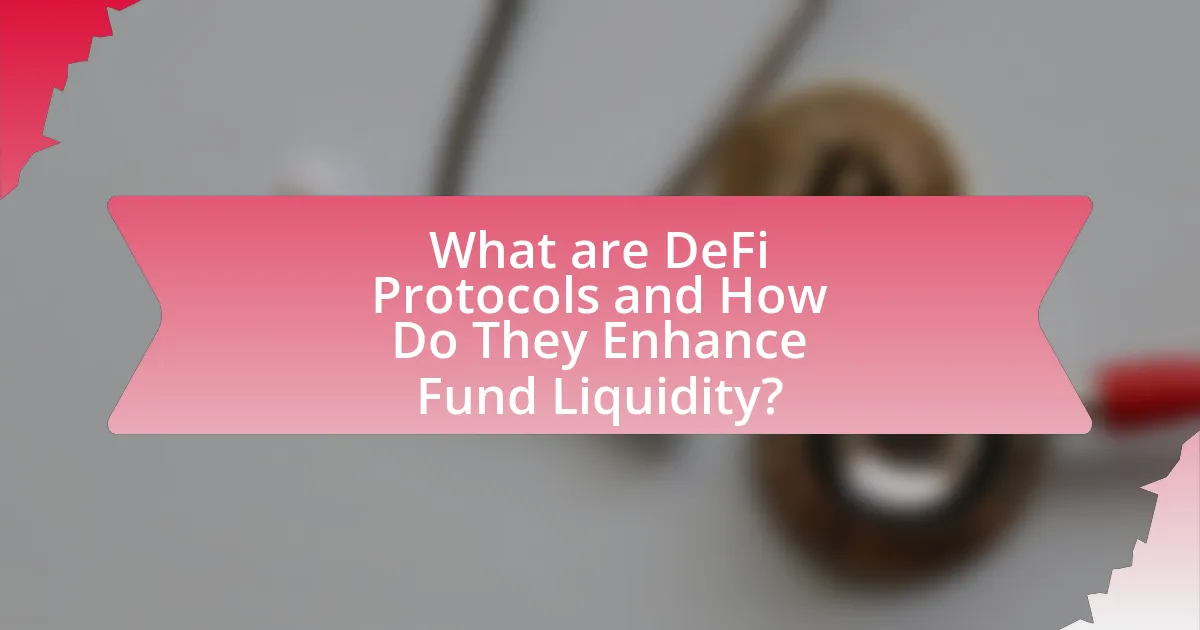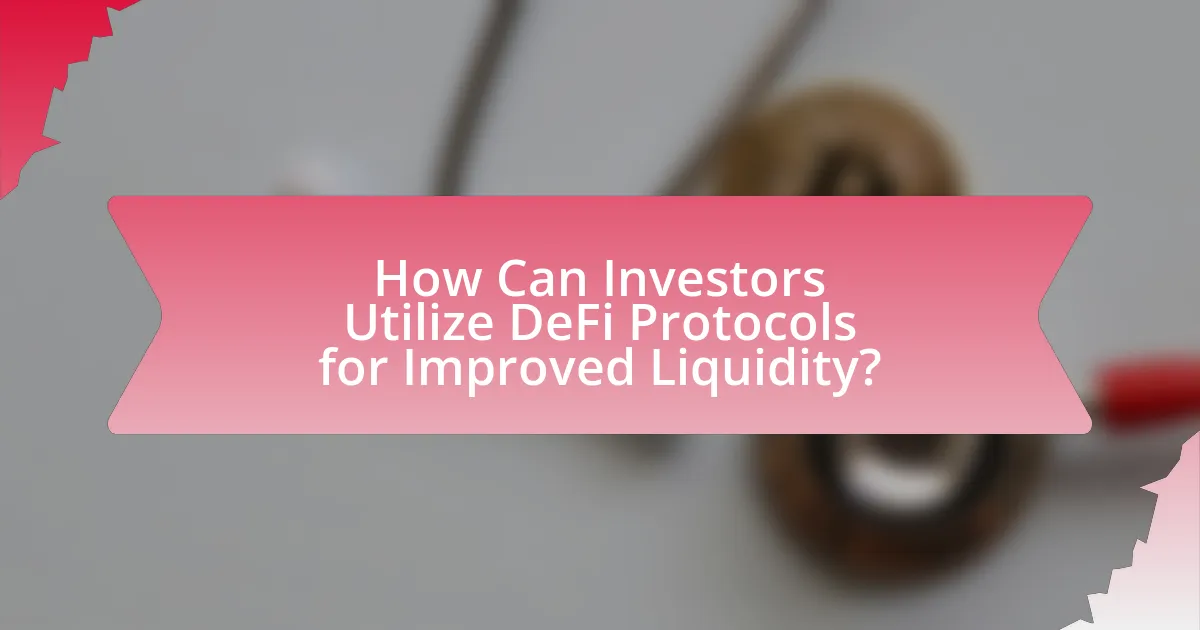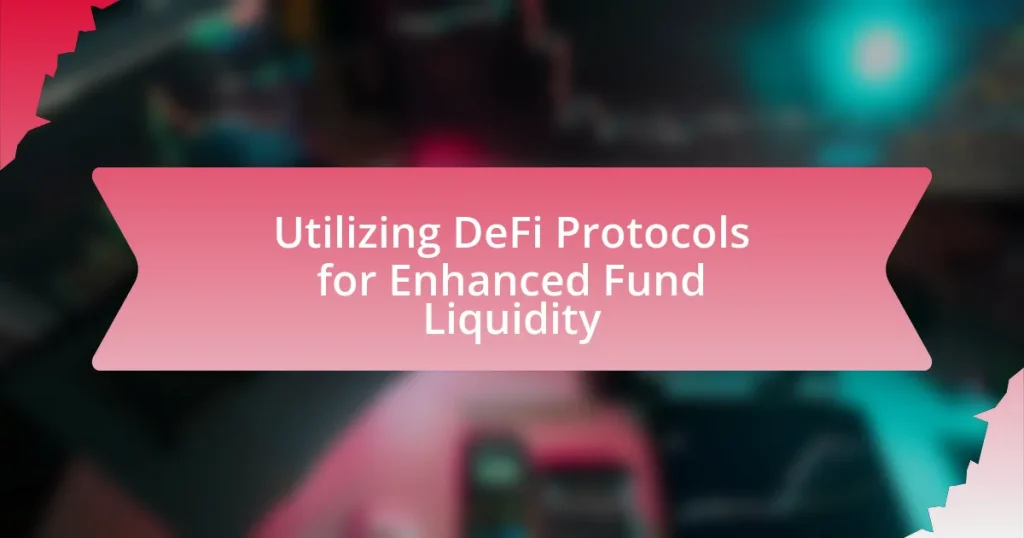DeFi protocols, or decentralized finance systems, facilitate financial services such as lending, borrowing, and trading without intermediaries, significantly enhancing fund liquidity. By utilizing smart contracts, liquidity pools, and decentralized exchanges, these protocols enable instant transactions and reduce reliance on traditional banking systems. Key components include automated market makers (AMMs) and governance mechanisms, which collectively improve market efficiency and accessibility. The article explores how investors can leverage DeFi protocols for improved liquidity, the advantages and risks associated with liquidity pools, yield farming, and staking, as well as best practices for safe participation in the evolving DeFi landscape.

What are DeFi Protocols and How Do They Enhance Fund Liquidity?
DeFi protocols are decentralized finance systems that enable financial services such as lending, borrowing, and trading without intermediaries. They enhance fund liquidity by allowing users to provide liquidity through automated market makers (AMMs) and liquidity pools, which facilitate instant transactions and reduce slippage. For instance, Uniswap, a leading DeFi protocol, allows users to trade tokens directly from their wallets, increasing market efficiency and liquidity. According to DeFi Pulse, the total value locked in DeFi protocols exceeded $80 billion in 2021, demonstrating their significant impact on liquidity in the cryptocurrency market.
How do DeFi protocols operate in the financial ecosystem?
DeFi protocols operate in the financial ecosystem by utilizing smart contracts on blockchain networks to facilitate decentralized financial services without intermediaries. These protocols enable users to lend, borrow, trade, and earn interest on their assets directly, enhancing liquidity by allowing instant transactions and reducing reliance on traditional banking systems. For example, platforms like Aave and Compound allow users to supply assets to liquidity pools, which are then used for lending, generating returns for the suppliers. This model not only increases accessibility to financial services but also promotes transparency and security through blockchain technology, as all transactions are recorded on a public ledger.
What are the key components of DeFi protocols?
The key components of DeFi protocols include smart contracts, decentralized exchanges (DEXs), liquidity pools, and governance mechanisms. Smart contracts automate transactions and enforce rules without intermediaries, ensuring transparency and security. Decentralized exchanges facilitate peer-to-peer trading of cryptocurrencies, eliminating the need for centralized authorities. Liquidity pools allow users to provide funds for trading pairs, earning fees in return, which enhances market liquidity. Governance mechanisms enable token holders to participate in decision-making processes, influencing protocol upgrades and changes. These components collectively contribute to the functionality and efficiency of DeFi protocols, driving the decentralized finance ecosystem.
How do these components interact to improve liquidity?
DeFi protocols improve liquidity through the interaction of smart contracts, liquidity pools, and decentralized exchanges. Smart contracts automate transactions and enforce rules without intermediaries, enabling seamless asset swaps. Liquidity pools aggregate funds from multiple users, allowing for greater availability of assets for trading, which reduces slippage and enhances market efficiency. Decentralized exchanges facilitate peer-to-peer trading, increasing market access and reducing reliance on centralized entities. Together, these components create a more efficient and accessible trading environment, evidenced by the growth of DeFi platforms, which saw total value locked increase from $1 billion in early 2020 to over $80 billion by late 2021, demonstrating enhanced liquidity in the market.
What advantages do DeFi protocols provide for fund liquidity?
DeFi protocols enhance fund liquidity by enabling instant access to capital through decentralized exchanges and automated market makers. These platforms facilitate peer-to-peer transactions without intermediaries, allowing users to trade assets quickly and efficiently. Additionally, DeFi protocols often utilize liquidity pools, which aggregate funds from multiple users, increasing the overall liquidity available for trading. This model reduces slippage and improves price stability, as evidenced by the significant growth of liquidity in DeFi markets, with platforms like Uniswap reporting billions in total value locked.
How do DeFi protocols reduce transaction costs?
DeFi protocols reduce transaction costs primarily by eliminating intermediaries and automating processes through smart contracts. By using blockchain technology, these protocols facilitate peer-to-peer transactions without the need for traditional financial institutions, which typically charge fees for their services. For instance, Ethereum-based DeFi platforms can execute trades and transfers directly on the blockchain, significantly lowering costs associated with manual processing and third-party involvement. Additionally, DeFi protocols often utilize liquidity pools, which allow users to trade assets with minimal slippage and lower fees compared to centralized exchanges. This efficiency is evidenced by the reduced average transaction fees on platforms like Uniswap, where users benefit from lower costs due to the automated nature of liquidity provision and trading.
What role does decentralization play in enhancing liquidity?
Decentralization significantly enhances liquidity by enabling a broader range of participants to engage in trading without the constraints of centralized intermediaries. In decentralized finance (DeFi), liquidity pools allow users to contribute assets, which increases the availability of funds for trading and reduces the impact of large trades on market prices. This mechanism fosters a more efficient market environment, as evidenced by the growth of decentralized exchanges, which have seen trading volumes surpassing billions of dollars daily, demonstrating the effectiveness of decentralized liquidity provision.

How Can Investors Utilize DeFi Protocols for Improved Liquidity?
Investors can utilize DeFi protocols for improved liquidity by participating in liquidity pools, which allow them to provide assets in exchange for transaction fees and rewards. By depositing cryptocurrencies into these pools, investors facilitate trading on decentralized exchanges, thereby enhancing market liquidity. For example, Uniswap, a leading DeFi protocol, enables users to earn fees proportional to their share of the pool, incentivizing liquidity provision. Additionally, investors can leverage automated market makers (AMMs) to access instant liquidity without relying on traditional order books, further streamlining the trading process. This approach not only increases asset accessibility but also allows investors to earn passive income through yield farming and staking, thereby maximizing their returns in a decentralized finance ecosystem.
What strategies can investors employ to maximize liquidity through DeFi?
Investors can maximize liquidity through DeFi by utilizing liquidity pools, yield farming, and decentralized exchanges (DEXs). Liquidity pools allow investors to provide assets to a pool in exchange for a share of transaction fees, enhancing liquidity while earning passive income. Yield farming involves staking or lending assets in various DeFi protocols to earn interest or additional tokens, which can further increase liquidity. Additionally, trading on DEXs enables investors to access a wide range of assets without relying on centralized exchanges, facilitating quicker transactions and better price discovery. These strategies leverage the decentralized nature of DeFi to optimize liquidity and returns.
How can liquidity pools be effectively utilized?
Liquidity pools can be effectively utilized by providing liquidity for decentralized exchanges, enabling users to trade assets without relying on traditional order books. By depositing assets into a liquidity pool, liquidity providers earn fees from trades that occur within the pool, creating a passive income stream. For instance, Uniswap, a leading decentralized exchange, allows users to earn a portion of the trading fees proportional to their contribution to the pool. This model incentivizes liquidity provision, as it enhances market efficiency and reduces slippage for traders. Additionally, liquidity pools can be utilized for yield farming, where users stake their assets in various protocols to earn rewards, further maximizing their returns.
What are the risks associated with using liquidity pools?
The risks associated with using liquidity pools include impermanent loss, smart contract vulnerabilities, and market volatility. Impermanent loss occurs when the value of assets in a liquidity pool diverges from holding those assets outside the pool, potentially leading to reduced returns. Smart contract vulnerabilities can expose liquidity providers to hacks or bugs, as funds are locked in code that may have flaws. Market volatility can lead to rapid price changes, impacting the value of assets in the pool and the overall returns for liquidity providers. These risks highlight the importance of understanding the mechanics and potential pitfalls of liquidity pools before participation.
How do yield farming and staking contribute to liquidity enhancement?
Yield farming and staking enhance liquidity by incentivizing users to lock their assets in decentralized finance (DeFi) protocols, thereby increasing the available capital for trading and lending. Yield farming allows users to earn rewards by providing liquidity to various pools, which directly increases the liquidity available for transactions. Staking, on the other hand, involves locking up tokens to support network operations, which also contributes to liquidity by ensuring that there are sufficient assets available for users to trade or borrow. According to a report by DeFi Pulse, the total value locked in DeFi protocols has reached over $80 billion, demonstrating the significant impact of yield farming and staking on liquidity enhancement in the ecosystem.
What are the differences between yield farming and staking?
Yield farming and staking are both methods used in decentralized finance (DeFi) to earn rewards, but they differ significantly in their mechanisms and risk profiles. Yield farming involves providing liquidity to decentralized exchanges or lending platforms in exchange for interest or tokens, often requiring users to move assets frequently to maximize returns, which increases risk and complexity. In contrast, staking involves locking up a specific cryptocurrency in a network to support its operations, such as validating transactions, in return for rewards, typically offering a more stable and predictable income with lower risk. The differences are underscored by yield farming’s reliance on liquidity provision and active management versus staking’s focus on network participation and passive income generation.
How can investors assess the profitability of these methods?
Investors can assess the profitability of utilizing DeFi protocols for enhanced fund liquidity by analyzing key performance indicators such as yield rates, transaction costs, and liquidity pool returns. Yield rates indicate the potential earnings from staking or providing liquidity, while transaction costs affect net profitability. For instance, a study by Messari in 2021 highlighted that liquidity providers in decentralized exchanges could earn annual percentage yields (APYs) ranging from 10% to over 100%, depending on the protocol and market conditions. Additionally, investors should evaluate historical performance data and compare it against traditional investment vehicles to determine relative profitability.

What Challenges and Considerations Exist When Using DeFi Protocols?
Challenges and considerations when using DeFi protocols include security risks, regulatory uncertainty, and smart contract vulnerabilities. Security risks arise from potential hacks and exploits, as evidenced by the $610 million hack of the Poly Network in 2021, highlighting the need for robust security measures. Regulatory uncertainty stems from the evolving legal landscape surrounding cryptocurrencies, which can impact the operation and adoption of DeFi platforms. Additionally, smart contract vulnerabilities can lead to significant financial losses; for instance, the DAO hack in 2016 resulted in a loss of $60 million due to a flaw in the smart contract code. These factors necessitate careful evaluation and risk management when engaging with DeFi protocols.
What are the potential risks of utilizing DeFi protocols for liquidity?
Utilizing DeFi protocols for liquidity carries several potential risks, including smart contract vulnerabilities, market volatility, and regulatory uncertainty. Smart contract vulnerabilities can lead to exploits, as evidenced by incidents like the $60 million hack of the bZx protocol in 2020, where attackers exploited a flaw in the smart contract code. Market volatility poses risks as liquidity pools can experience significant price fluctuations, impacting the value of assets held within them. Additionally, regulatory uncertainty can affect the operation of DeFi protocols, as governments may impose restrictions or regulations that could hinder their functionality or legality, as seen with various countries considering or implementing regulations on cryptocurrency activities.
How can smart contract vulnerabilities impact fund liquidity?
Smart contract vulnerabilities can significantly impact fund liquidity by exposing funds to potential theft or loss, which can deter investors from participating. When a smart contract contains flaws, such as reentrancy attacks or improper access controls, it can lead to unauthorized access or manipulation of funds. For instance, the DAO hack in 2016 resulted in the loss of $60 million worth of Ether due to a vulnerability in the smart contract code, causing a loss of confidence in the platform and affecting liquidity. Consequently, if investors perceive a high risk associated with smart contracts, they may withdraw their funds or avoid investing altogether, leading to decreased liquidity in the market.
What regulatory challenges should investors be aware of?
Investors should be aware of regulatory challenges such as compliance with anti-money laundering (AML) and know your customer (KYC) requirements when utilizing DeFi protocols for enhanced fund liquidity. These regulations vary by jurisdiction and can impact the operational capabilities of DeFi platforms. For instance, in the United States, the Financial Crimes Enforcement Network (FinCEN) mandates that cryptocurrency exchanges implement AML and KYC measures, which can complicate the user experience and limit access to certain services. Additionally, the evolving nature of regulations in the DeFi space poses risks, as regulatory bodies may introduce new rules that could affect the legality and functionality of existing protocols.
How can users mitigate risks while engaging with DeFi protocols?
Users can mitigate risks while engaging with DeFi protocols by conducting thorough research on the protocols, utilizing risk assessment tools, and diversifying their investments. Conducting research involves analyzing the protocol’s smart contracts, governance structure, and historical performance to identify potential vulnerabilities. Risk assessment tools, such as audits from reputable firms and analytics platforms, provide insights into the security and reliability of the protocols. Diversifying investments across multiple DeFi platforms reduces exposure to any single protocol’s failure, thereby spreading risk. These strategies are supported by data indicating that informed users who assess risks and diversify their portfolios experience lower losses in volatile markets.
What best practices should be followed for safe participation in DeFi?
To safely participate in DeFi, users should follow best practices such as conducting thorough research on protocols, using secure wallets, enabling two-factor authentication, and being cautious of phishing attacks. Conducting research ensures that users understand the risks and functionalities of the protocols they engage with, as evidenced by the high number of scams and vulnerabilities reported in the DeFi space. Using secure wallets, particularly hardware wallets, protects assets from online threats, as software wallets are more susceptible to hacks. Enabling two-factor authentication adds an extra layer of security, reducing the likelihood of unauthorized access. Lastly, being vigilant against phishing attacks is crucial, as these tactics are commonly employed to steal sensitive information. Following these practices significantly mitigates risks associated with DeFi participation.
How can users stay informed about changes in the DeFi landscape?
Users can stay informed about changes in the DeFi landscape by following reputable news sources, engaging with community forums, and utilizing social media platforms. Reputable news sources like CoinDesk and Decrypt provide timely updates on market trends and regulatory changes. Community forums such as Reddit and Discord allow users to discuss developments and share insights with other enthusiasts. Additionally, social media platforms like Twitter are often used by industry leaders and projects to announce updates and engage with their audience, making them valuable for real-time information.
What are the best practices for maximizing fund liquidity in DeFi?
To maximize fund liquidity in DeFi, investors should utilize automated market makers (AMMs), diversify liquidity pools, and engage in yield farming. AMMs facilitate instant trades without the need for order books, enhancing liquidity by allowing users to trade directly against liquidity pools. Diversifying across multiple liquidity pools reduces risk and increases the chances of earning fees from various sources, as different pools may have varying levels of activity and returns. Yield farming, which involves staking assets in liquidity pools to earn rewards, can further enhance liquidity by incentivizing users to provide more capital. These practices are supported by the growing adoption of DeFi platforms, which have seen total value locked (TVL) in DeFi protocols exceed $100 billion, indicating a robust ecosystem that rewards liquidity provision.















